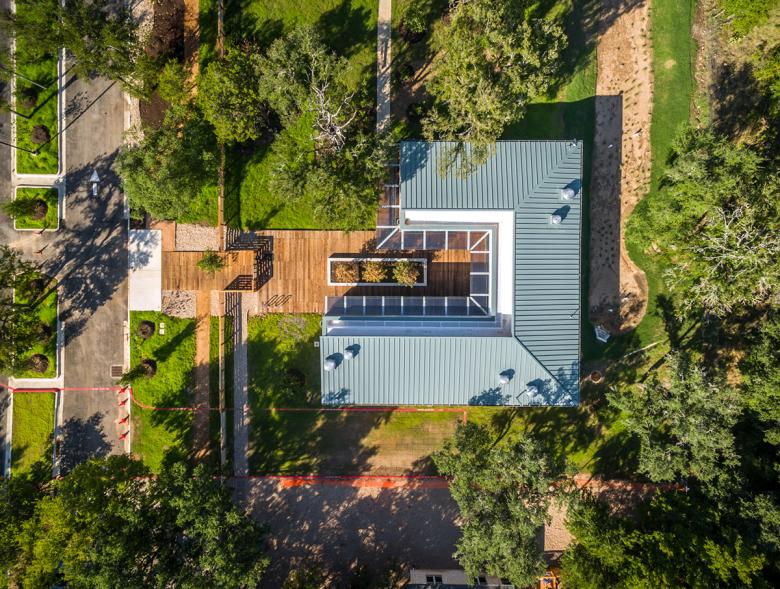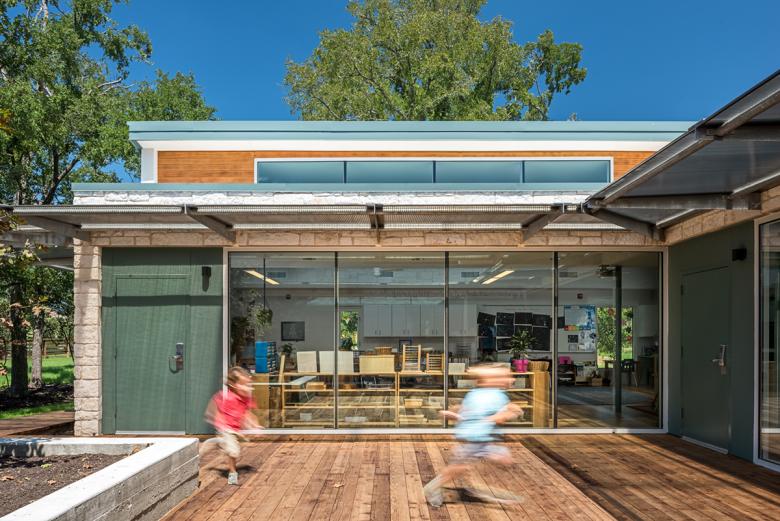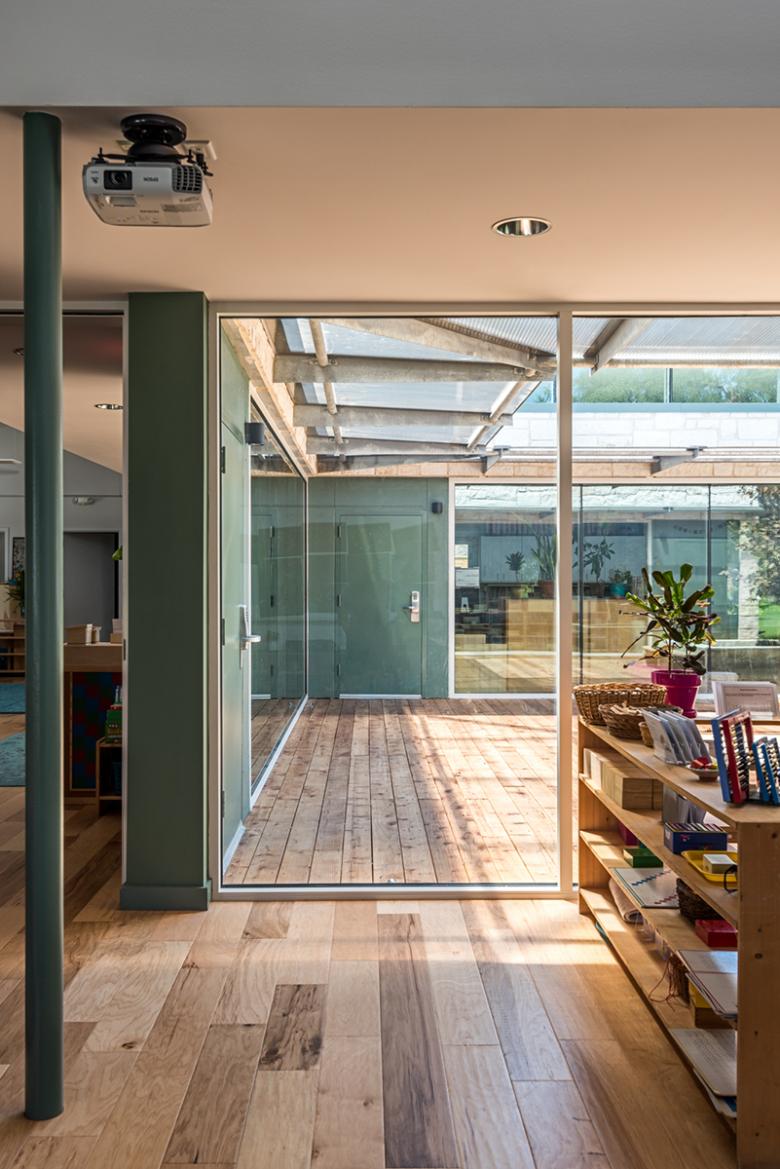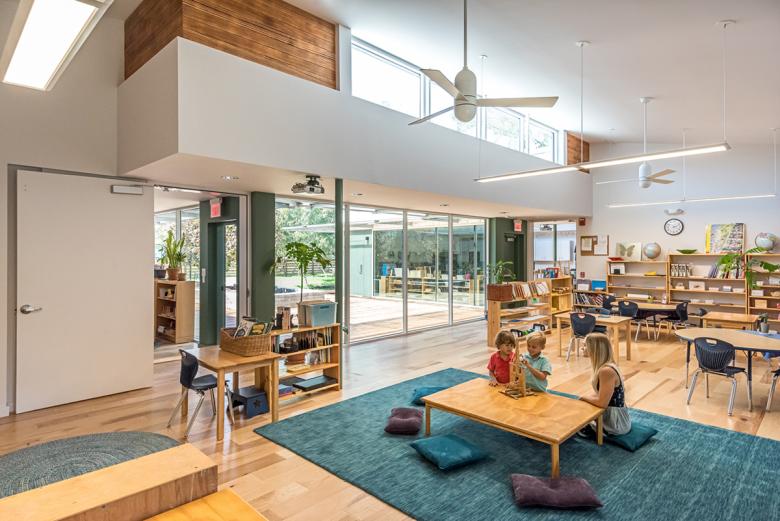Khabele Elementary Expansion
25. de gener 2016
The expansion of the private Khabele School's campus in Austin, Texas, started modestly for architect Tim Derrington: "simple additions, small permitting projects, even the design of a perimeter fence." But it blossomed into the school's first new building, which Derrington describes as "a crisp play on Central Texas vernacular." The architect answered a few questions about the small, light-filled project.
The guiding design vision was that of a village in the forest, therefore maintaining as many trees as possible was a priority. The layout of the buildings was determined to maximize the saving of existing trees.
What were the circumstances of receiving the commission for this project?
The Khabele School is a small, but growing, community that we have worked with for many years. In fact, the school was Tim Derrington’s first client.
Tim Derrington, Principal, Derrington Building Studio:
The polygal awning wraps the building to protect the doors and windows, as well as pedestrians below. During a central Texas thunderstorm, raindrops create the soothing background sound of a muffled snare drum.
Please provide an overview of the project.
The project pictured is the first phase of a two- or three-phase campus expansion effort. In 2013, the Khabele School purchased a 4-acre property with an existing daycare facility to expand their rapidly growing Montessori-based elementary program. In the school’s initial meeting with Derrington Building Studio principal, Tim Derrington, their directive was simple: design the campus as "a village in the forest." The school’s limited budget and tight schedule, along with the site’s sensitive environmental restrictions, posed unique challenges.
The courtyard is warmly lit during evening hours and is nestled by the protective walls of the Mission-inspired facade.
Derrington Building Studio translated this vision for Khabele’s progressive community into architecture through a crisp play on Central Texas vernacular. The new building facade unites the campus by incorporating an existing masonry pattern from their prominent existing kindergarten building. Circulation extracted from the interior and brought to the exterior capitalizes on the local climate while minimizing impervious ground cover. This also maximizes the classroom spaces and obliges interaction with the surrounding elements. This open spatial experience and natural material palette creates an inviting learning environment that fosters growth for students’ minds and well-being.
Side shot of the courtyard on a sunny afternoon.
What are the main ideas and inspirations influencing the design of the building?
As mentioned before, the Khabele School came to us with a vision of a village in a forest. We embraced this vision and balanced it with the existing conditions of the site. There was an existing daycare building, about 8000 sq. ft., built in a conventional "Texas Hill Country" style: limestone masonry, punched windows, and low-sloped roof. We decided to draw inspiration from both the vision provided and the idea of Texas vernacular. Pulling from early Texas vernacular (Spanish missions), we created eaveless masses with a somewhat fortified exterior presence. Eaveless conditions open up to a more modern courtyard experience with abundant transparency, sunshine, and planters. We also broke each zone of the campus into a separate building to provide the village-like/clustered experience, and populated the negative space with as many trees as possible.
From the beginning, the courtyard was intended to be an extension of the classroom space. Inside and outside blend seamlessly.
The main circulation path is broad enough to be thought of like an avenue and can accommodate gatherings and spontaneous play.
How does the design respond to the unique qualities of the site?
Due to environmental sensitivity, the site is zoned with a maximum developable footprint of 40% impervious cover, which limited our square footage considerably. All circulatory space was pushed outside the envelope of the building, to engage the kids with the site, as well as reduce impervious cover (wooden decks only count as 50% impervious by the City of Austin).
The buildings were designed to create semi-protected outdoor spaces to expand the perceived limits of the architecture and space. While the zoning limited the footprint of the classrooms, large windows looking onto broad deck allows the imagination to wonder beyond the confines of the building’s outer walls.
We also engaged with trees, and placed the buildings such that we minimized existing tree removal. Any trees that had to be removed, were replaced with new trees.
The existing building (not pictured) adjacent to this one is a Texas Hill Country-styled former daycare center. It has a hipped roof and limestone walls. The intention is for that building to remain an integral part of the campus.
Strong lines of symmetry govern the layout of the classroom spaces.
How did the project change between the initial design stage and the completion of the building?
The original detailing of the school was more in line with custom residential design rather than a small commercial or educational building: zero-edge window conditions, custom-built specialty doors, etc. However, once initial construction pricing was reviewed, practical decisions were made to bring the cost within budget. The team decided to modify the details to simplify constructability as well as long-term issues such as maintenance. The details became a bit more conventional and we believe this was a good move because, just like with anything else, conventional pieces tend to be more readily available and require less skilled labor to handle, thereby reducing the cost upfront and over the life of the building. We were very happy with the cost reduction efforts made by the whole team and are thrilled these modifications did not negatively impact the essence of the design.
Email interview conducted by John Hill.
Clerestory lights open up the ceiling and lift one’s eyes to the tree canopies and clouds above. During the opening celebration, one of the teachers mentioned at that she had yet to turn the lights on during school hours.
1. Existing Office
2. Existing Building
3. New Administration
4. New Art
5. New Lower Elementary
6. New Upper Elementary
7. New Flex
8. New Storage
Khabele Elementary Expansion
2015Austin, Texas
Client
The Khabele School
Architect
Derrington Building Studio
Austin, Texas
Design Principal
Tim Derrington
Project Architect
Heath Henderson
Structural Engineer
Structures
MEP/FP Engineer
EEA Consulting Engineers
Civil Engineer
Thompson Land Engineering
Landscaping
Riata Landscape Services
Contractor
American Constructors
Construction Management
Scott Cooper, Belinda Santolucito, Andrew Spitzfaden
Masonry
Texas Limestone
Storefront and Glazing
Morris Glass – Tubelite 14000 Series Flush Glaze
Redwood Decking
Metalink Corporation
Pecan Flooring
Chase Flooring Group
Site Area
2 acres
Building Area
3,432 sf
Photographs
Peter Molick Photography
Articles relacionats
-
Spotlight on Italy
16/5/18
-
Bologna Shoah Memorial
20/7/15










